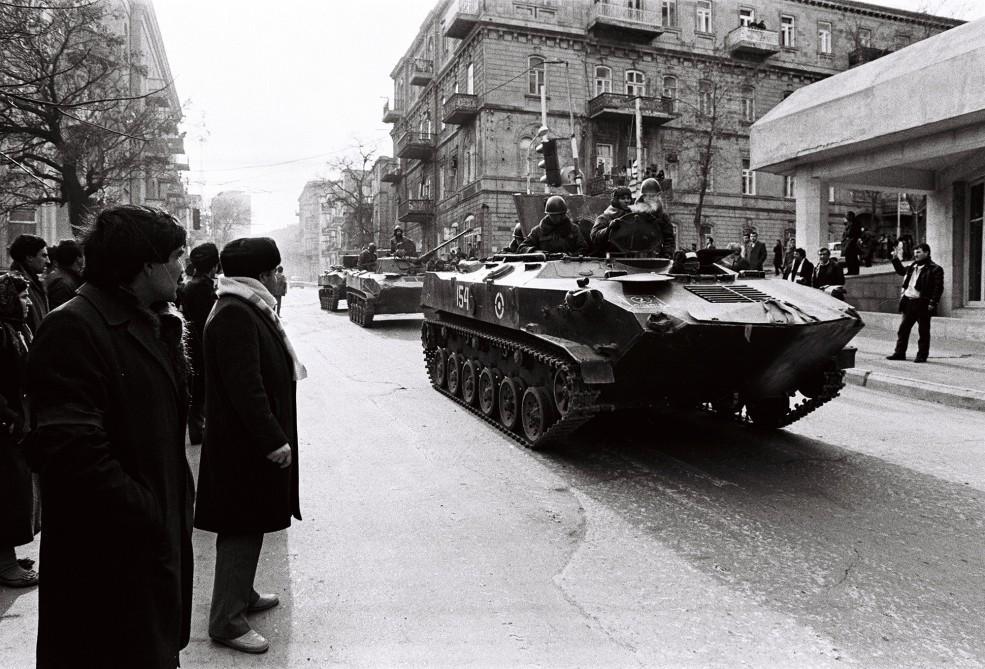Historian: January pogroms in Baku committed by Armenian nationalists at behest of Soviet Union's leadership

By Trend
From year to year, the Armenian propaganda campaign continues to impose on the world community a far-fetched version of the events of January 1990, and the pogroms in Baku and Sumgayit, which allegedly provoked a massacre of Armenians, Rizvan Huseynov, Director of the Center of Caucasian History, told Trend.
In this sense, this year was no exception in the Armenian media, the renowned Azerbaijani historian said, adding that falsifying historical facts, Armenians have launched an anti-Azerbaijani campaign in an attempt to mislead the world community again.
"When the Armenian side begins to talk about the pogroms in Baku in January 1990, then it is apparently lying because these very events were preceded by a whole series of tragic events and provocations that cannot be kept in disguise," Huseynov noted.
"If they talk about the Armenian-Azerbaijani conflict, then we must return to the events in 1987-88, when the first pogroms and expulsions of Azerbaijanis from the territory of Armenia began. It was at that time that atrocities were committed in Kapan, in Gugark and other regions of Armenia, where Azerbaijanis were brutally expelled or killed. It was the first wave of refugees from the end of 1987 and the beginning of 1988 that flooded the streets of Azerbaijan's large cities - Baku, Sumgayit, Ganja and others, when destitute people became a kind of first catalyst for the events that led to the development of the Karabakh conflict," said the historian.
"It was 100-percent provocation by the Soviet KGB, which was carried out by the hands of nationalists, and in particular - party leaders, heads of police, districts, prosecutors - in a word, dignitaries of Armenia who participated in the expulsion of Azerbaijanis and thereby inspired the Armenian nationalists to these atrocities," he added.
“The USSR witnessed the picture; and the Gorbachev leadership actually provoked all these events, forcing the Azerbaijani side to take retaliatory measures,” said Huseynov. “Thus, these dispossessed people appeared in Azerbaijan’s Sumgait city as well, where, not without the support of the State Security Committee, everything was done not to let the city leadership and law enforcement agencies to act.”
“At that time, somehow, in anticipation of the Sumgait events, a huge group of criminal masterminds from all over the USSR appeared there,” the historian noted. “Who brought them is also understandable, since without an allied leadership this operation wouldn’t have succeeded. As a result, the city was paralyzed, after which there were riots led by Armenian Eduard Grigoryan, his brothers and other Armenians.”
“Nationalists beat, killed and raped the Armenians, and the purpose of this provocation was to justify the further occupation of Azerbaijani territories and large-scale aggression against the Azerbaijani people,” Huseynov said.
The historian reminded that literally immediately after the Sumgait events, a biased anti-Azerbaijani campaign was launched in the Soviet and foreign media to denigrate Azerbaijan.
“They tried to represent the Azerbaijani people as a monster, to attribute all the atrocities exclusively to the Azerbaijani people, while initially all this monstrous provocation was launched by Armenia, in particular, by the Armenian State Security Committee and the nationalists of this country,” Huseynov noted.
“Following this, the events inNagorno- Karabakh began to develop in a more dangerous way, rallies and riots by the Armenian separatists in Karabakh started,” said the historian. “The Armenian separatists sought to separate Nagorno-Karabakh from Azerbaijan, hostilities began, and all these events caused fair indignation of the Azerbaijani people.”
“Amid the complete inaction of the then Azerbaijani leadership, the situation was menacing,” Huseynov said. “As a result, a great part of the Azerbaijani intelligentsia came to the conclusion that it was necessary for Azerbaijan to gain independence to save its sovereignty and territorial integrity as the Soviet leadership of the Azerbaijan Republic was unable to do this.”
“In fact, the national liberation movement has started since 1988,” the scholar added. “The peak of this movement was the subsequent events of January 1990. While realizing the seriousness of the events, the Soviet Union Center again provoked the so-called riots of Armenians to justify sending of a huge contingent of the Soviet troops to Baku. Thus, a war was declared to the Soviet city of Baku. A contingent of troops, comparable to the contingent of the Soviet troops sent to Afghanistan during the war, was sent to Baku. The war against the Azerbaijani people was unambiguously declared.”
“This is the reality,” Huseynov said. “Therefore, if the current Armenian media outlets, journalists and the Armenian leadership do not realize that there were forces, in which the Armenian provocateurs and nationalists played a big role, trying to stop the national liberation movement in Azerbaijan, then they are simply blind. In this situation, Armenia attempted to prevent Azerbaijan to gain independence.”
“As a result, the 'Karabakh map' was used to turn the national liberation movement into an interethnic conflict, and the goal was partially achieved,” the scholar said. “Nevertheless, the Azerbaijani people eventually gained independence. I think that this period, which turned into disorder and riots followed by the January 20 tragedy, is the chain of provocations of the Armenian side and the Soviet Union Center aimed at undermining the national liberation movement in Azerbaijan.”
---
Follow us on Twitter @AzerNewsAz
Here we are to serve you with news right now. It does not cost much, but worth your attention.
Choose to support open, independent, quality journalism and subscribe on a monthly basis.
By subscribing to our online newspaper, you can have full digital access to all news, analysis, and much more.
You can also follow AzerNEWS on Twitter @AzerNewsAz or Facebook @AzerNewsNewspaper
Thank you!
